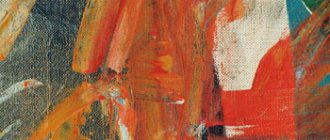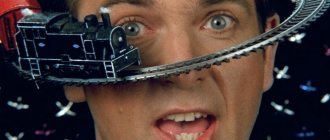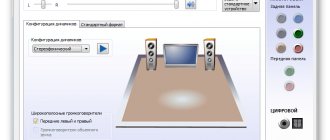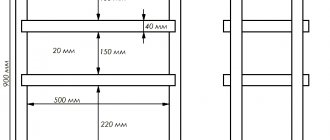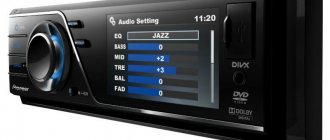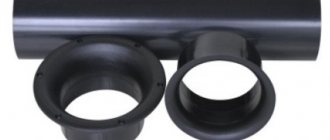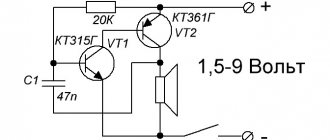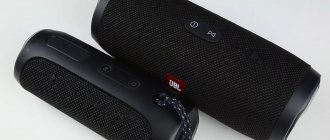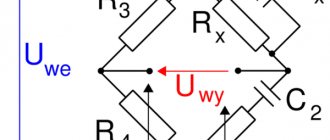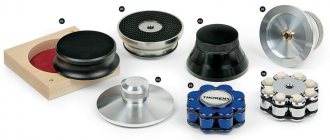When we purchase high-quality audio equipment, we are faced with the question of how to configure it correctly, taking into account the influence of the room.
And if our system has a subwoofer and/or is multi-channel, then the question arises of how to adjust the sound, taking into account the delays in the passage of sound from the speakers to the listener’s location. You can do this by ear, but it is more convenient to use test discs, which allow you to identify incorrect speaker connections, incorrect subwoofer settings, etc. Types of audio tests
Test discs
How to listen to acoustics correctly (simple technique)
How to properly listen to 5.1, 7.1 speakers
How to choose acoustics
How to choose an amplifier for speakers, how to connect speakers
Connecting a subwoofer. Installation, configuration.
To test audio equipment when purchasing, it is recommended to take with you your favorite songs that you know well how they sound. You can take high-resolution tracks downloaded from the Internet. But you will need to burn them to CD because... in a hi-fi salon there may not be an alternative sound source to adequately listen directly to high-resolution audio files. Therefore, you will have to carry out an operation to reduce the sampling frequency and bit depth to 16 bits/44 kHz. To do this you will need a high quality audio converter.
AuI ConverteR 48×44 - HD audio converter for high-resolution music files FLAC, WAV, WAV/BWF, WAV/RF64, AIF, AIFF, AIFF/sowt, ALAC, mp3, OGG, AAC, WMA, DTS, AC3 CD ripper ( for Mac OS X and Windows)
Types of audio tests:
1. Detecting the antiphase of stereo channels (the red and black wires on the speaker are reversed):
— pink noise;
- speech.
If the sound sounds clear and is located in the center between the speakers, then the speakers are connected correctly - in phase.
If the sound is blurry (compared to the previous version, it acquires volume, like stereo compared to mono), then you need to swap the wires on one of the speakers, or even better, connect them correctly: the red connector of the speakers to the red connector of the amplifier, and the black connector to the amplifier. to black.
2. Setting uniform volume over the entire frequency range.
3. Special pieces of music to check the quality of the tuning.
Test sound clips and sets
Denon Audio Technical CD (lossless) Audio CD from Danon, designed for testing and tuning a wide variety of audio equipment. (WAV+CUE; compressed with WavPack lossless encoder).Tracks: 1. Channel (L,R) 2. Balance, Phase (L+R,LR) 3. Orchestra (Stereo) 4. Concerto (Stereo) 5. Chamber Music (Stereo) 6. Piano (Stereo) 7. Organ (Stereo) 8. Jazz (Stereo) 9. Rock (Stereo) 10. Announcement English (Stereo) 11. Announcement Japanese (Stereo) 12. 1001Hz Sine Wave (-15dB L,R) 13. 1001Hz Sine Wave (-15dB L +R) 14. 1001Hz Sine Wave (-16dB L+R) 15. 1001Hz Sine Wave (-18dB L+R) 16. 1001Hz Sine Wave (-20dB L+R) 17. 1001Hz Sine Wave (-15dB LR) 18 1001Hz Sine Wave (0dB L) 19. 1001Hz Sine Wave (0dB R) 20. 9999Hz Sine Wave (0dB L) 21. 9999Hz Sine Wave (0dB R) 22. 100Hz Sine Wave (0dB L) 23. 100Hz Sine Wave ( 0dB R) 24. 19999Hz Sine Wave (0dB L) 25. 19999Hz Sine Wave (0dB R) 26. 21.5Hz Sine Wave (0dB L) 27. 21.5Hz Sine Wave (0dB R) 28. 1001Hz Sine Wave (0dB L) 29. 1001Hz Sine Wave (0dB R) 30. 1001Hz Sine Wave (-24dB L) 31. 1001Hz Sine Wave (-24dB R) 32. 1001Hz Sine Wave (-60dB L) 33. 1001Hz Sine Wave (-60dB R) 34 Infinity Zero (L+R) 35. Infinity Zero (L+R) 36. 1KHz, 20Hz-20KHz (-20dB L) 37. 1KHz, 20Hz-20KHz (-20dB R) 38. 1KHz, 20Hz-20KHz (- 20dB L) 39. 1KHz, 20Hz-20KHz (-20dB R) 40. 250Hz+8020Hz (0dB L) 41. 250Hz+8020Hz (0dB R) 42. 250Hz+8020Hz (-10dB L+R) 43. 11KHz+12KHz (0dB L) 44. 11KHz+12KHz (0dB R) 45. 11KHz+12KHz (-10dB L+R) 46. 40Hz Sine Wave (0dB L+R) 47. 100Hz Sine Wave (0dB L+R) 48. 315Hz Sine Wave (0dB L+R) 49. 1001Hz Sine Wave (0dB L+R) 50. 3149Hz Sine Wave (0dB L+R) 51. 6301Hz Sine Wave (0dB L+R) 52. 9999Hz Sine Wave (0dB L+ R) 53. 15999Hz Sine Wave (0dB L+R) 54. 17999Hz Sine Wave (0dB L+R) 55. 19999Hz Sine Wave (0dB L+R) 56. 100Hz Sine Wave (-20dB L+R) 57. 1001Hz Sine Wave (-20dB L+R) 58. 9999Hz Sine Wave (-20dB L+R) 59. 100Hz Sine Wave (-40dB L+R) 60. 1001Hz Sine Wave (-40dB L+R) 61. 9999Hz Sine Wave (-40dB L+R) 62. 100Hz Sine Wave (-60dB L+R) 63. 1001Hz Sine Wave (-60dB L+R) 64. 9999Hz Sine Wave (-60dB L+R) 65. 1KHz,5Hz-22.05 KHz (-15dB L+R) 66. 1001Hz,-20dB, -60dB-0dB (L+R) 67. 100Hz, -20dB, -60dB-0dB (L+R) 68. 9999Hz, -20dB, -60dB- 0dB (L+R) 69. 401Hz, 0?, 0?-360? (0dB) 70. 401Hz, 0?, 0?-360? (-20dB) 71. 100Hz Square Wave (-10dB L+R) 72. 1001Hz Tone Burst EIA (0dB L+R) 73. 1001Hz Tone Burst EIAJ (0dB L+R) 74. 401Hz Tone Burst (0dB L+R) ) 75. 4000Hz Tone Burst (0dB L+R) 76. Impulse I (0dB L+R) 77. Impulse II (0dB L+R) 78. Pulsive Signal 40mS (0dB L+R) 79. White Noise (0dB L +R) 80. 25Hz,31.5Hz,40Hz (-20dB/-16dB L/R) 81. 50Hz, 63Hz, 80Hz (-20dB/-16dB L/R) 82. 100Hz, 125Hz, 160Hz (-20dB/- 16dB L/R) 83. 200Hz, 250Hz, 315Hz (-20dB/-16dB L/R) 84. 400Hz, 500Hz, 630Hz (-20dB/-16dB L/R) 85. 800Hz, 1KHz, 1.25KHz (-20dB /-16dB L/R) 86. 1.6KHz, 2KHz, 2.5KHz (-20dB/-16dB L/R) 87. 3.15KHz, 4KHz, 5KHz (-20dB/-16dB L/R) 88. 6.3KHz, 8KHz , 10KHz (-20dB/-16dB L/R) 89. 12.5KHz, 16KHz (-20dB/-16dB L/R) 90. Pink Noise (-14dB L+R) 91. 3150Hz Sine Wave (-20dB L+R ) 92. FFFF/0000 22.05KHz (ILSB L+R) 93. Orchestra, Piano (-60dB Stereo) 94. Orchestra, Piano (-40dB Stereo) 95. Orchestra, Piano (-20dB Stereo) 96. Orchestra, Piano ( Normal Stereo) 97. Music I x4 (Normal Stereo) Listen 98. Music II x4 (Normal Stereo) 99. Music III x4 (Normal Stereo)
Test discs
AudioDoctor FSQ (2006), AudioDoctor FSQ 2 (2006)
Specially made for tuning audio systems, but can also be used for home systems)
Martini to the music. Educational and training disk Focal Teach (2008)
Software disk. Contains a training program (demonstration of CD and mp3 sound features, stereo, mono, antiphase, types of frequency and amplitude distortions, absence/presence of harmonics, etc.). There are also 2 tests of different difficulty levels, as a result of which the test taker is given a score.
Deep Bass (2004)
Music with deep bass to test your subwoofer settings or the low-frequency capabilities of your speakers.
Onkyo Test DVD
Music and video multi-channel sound.
High-End Test-CD (1994)
Prime Test Vol. 1, 2 (2004)
Bowers & Wilkins With Real World Records (2007)
Focal Demo - Disc Vol.1 (1996)
The Linn Collection Edition (1992)
Linn Records - The Super Audio Surround Collection Vol. 1, 2, 3 (2007)
Linn Selections - The Super Audio Surround Vol.1 (2004)
Wilson Audio - Ultimate Reference CD (2000)
Focal JMlab 2 Tools CD
Focal JMlab - No. 1 (1995), 3 (1998), 5 (2002), 6 (2005), 7 (2008)
Mauro De Federicis - Canzoni... And More (2007)
Official USAC Competition (1997)
Legacy
Ultradisc II Sampler (1994)
Additional material
| To contents |
- Test disc from Naim Audio - disc released with Avtozvuk magazine, No. 5, 2003.
- Audio Store Test CD 1 – the first test disc from Anatoly Markovich Likhnitsky
- McIntosh Audiophile Test Reference CD – Japanese collection of classics from McIntosh
- Focal.JMlab No.3: Le grand spectacle du son – French collection of reference recordings from in-akustik GmbH & Co. KG
- Interstudio Sound Check 2 Test CD – test disc by Alan Parsons
- Ultimate Demonstration Disk – demo disc with high quality recordings from Chesky Records
- Raoul Sanchez Test CD – test collection from Raoul Sanchez
- Philips Test CD - a disc for testing and tuning CD players
- Claude Debussy: Jeux, Images, Musiques pour “Le Roi Lear”, © 2002 EMI Records Ltd., disc 5 75217-2, LC 6646
- Goran Bregović — Music for Films, © 2000 Mercury France, disc 546 204-2
- Jacques Loussier Trio - Satie: Gymnopédies/Gnossiennes, © 1998 Telarc Digital, disc 0 83431-2
- Pink Floyd - Dark Side of the Moon, © 1994 EMI Records Ltd., disc 8 29752-2
In this section
test discs and albums
not included in the main collection
.
The section is under development.
Test disc from Naim Audio
Together with the magazine “Avtozvuk”, No. 5, 2003.
A disc was released, which is a collection of high-quality recordings from Naim Audio.
As test material, this collection is very good, primarily due to the presence of documentary
records, i.e. received directly from a pair of microphones. It is no less good as a demonstration one. However, it is less suitable for speaker tuning than the Linn Records compilation.
As with The Best of Linn Records, quotes
from the corresponding issue of the magazine.
The comments
are compiled in a similar way .
From the producer.
In fact, Naim manages very well without this staff unit, giving artists the opportunity to produce themselves. Complete freedom when working in the studio, although it contributes to the creation of a creative atmosphere, but requires more time and highly qualified technical personnel. Our task came down to choosing compositions and solving organizational issues, i.e. purely production activities.
For Naim Audio founder Julian Vereker, recording was one of his many passions. In the early 90s, the company released its first CD player, and the first difficulty faced by the marketing department was the lack of decent discs to demonstrate it. Werker begins experimenting in the studio, trying to understand why CDs, with clearly better technical characteristics, are inferior in sound to good old vinyl. He is joined by Ken Christianson, Naim Audio's American distributor and a sound engineer with extensive showbiz connections. Julian finds an advanced studio in London, Finesplice, where he digitizes several master tapes, and his partner looks for interesting musicians for future projects. These audiophile releases remain in limited editions to this day and are distributed through Naim Audio distributors.
We have selected works from a wide range of genres from the Naim catalog - jazz, flamenco, piano and chamber music, fusion, new age, etc. I wanted the collection to not only be pleasant to listen to, but also to serve as professional demonstration and test material.
Special thanks to Paul Stephenson and Anna Tooth from Naim Audio, as well as Sergei Troshin (Esoterica) for their assistance in making this project possible.
Nikolay Efremov
About the recording.
All Naim albums were recorded by either Ken Christianson in the US or Peter Williams at Finesplice Studios in London. Ken prefers to feed the signal from two microphones directly to a two-track tape recorder, eliminating everything except limiters from the path. The simplicity of this method is apparent, since only a very experienced sound engineer can convey all the details and shades of the sound picture using such meager means.
Peter, on the contrary, uses a large number of microphones, the most modern and sophisticated equipment, incl. computer However, it is needed for control, editing and digitization, and it also has nothing superfluous directly in the sound channel.
The two schools do not argue with each other, but complement each other. Phonograms made in different ways, of course, differ in hearing, but there is no trace of dissonance.
Total volume 12
archives –
363,076,575
bytes, total playing time of the compositions –
67 minutes 40 seconds
(179,026,798 counts).
| No. | Song name | File | Comments |
| 1 | Antonio Forcione & Sabina Sciubba - Could You Believe? | tna01.zip19,355,452 | Guitarist Antonio Forchione's musical career began at the age of 13, when he formed his own band and began touring Italy. He studied music in Rome and later graduated from the Art Institute with a degree in painting and sculpture. In 1983, a year after moving to England, he recorded his debut album, Light a Shade. Then nine more were released on Virgin, Jazzpoint and Naim labels, and several of them reached the top ten of the UK jazz charts. However, Forchione does not adhere to the jazz mainstream; it is rather new age or even acid jazz, masterfully performed on an acoustic guitar. His compositions are often used in films and television. He recorded with Phil Collins, Bobby McFerrin, Van Morrison, Zucherro and other European stars. Sabina Subba became famous as the soloist and art director of the musical comedy “Ole!”, incredibly popular in Europe. She often performs as a session vocalist with A-list stars, incl. and jazz. She has a unique timbre and is very emotional. |
| 2 | Acoustic Mania - Snow | tna02.zip25,320,516 | The duet of Antonio Forchione and Neil Stacey was formed in 1993. The joint work of two virtuoso guitarists in the genres of flamenco, Latin, classical and jazz has a lot of fans all over the world. Acoustic Mania has played festivals throughout Europe, the Caribbean, Indonesia and Kazakhstan. In terms of performance technique and sound, the music is very close to John McLaughlin, with whom, by the way, the duo performed several times. What is attractive about this recording is not even the skill of the musicians (rave reviews are constantly published in the press), but the clear three-dimensional picture built by two instruments. Appreciate the transmission of nuances, reverberation, and careful drawing of every detail. |
| 3 | Patrick Noland - Beyond a Trance | tna03.zip17,002,797 | American pianist and composer Patrick Noland was invited to Naim by Ken Christianson. He was attracted by the sensual and at the same time filigree performance of piano works. The recording was made at the Church of the Ascension in the small town of Oak Park, Illinois. As always, Ken adhered to the principle: 2 microphones - 2 channels, i.e. the signal from a carefully matched pair of Neumann U87s was fed through a tube linear amplifier to the input of a two-channel Nagra 4S reel-to-reel amplifier and in parallel to a DAT TASCAM DA45. There was nothing else in the path except limiters. Pay attention to the richness of the sound of the instrument, and most importantly, to the absolutely reliable reproduction of the acoustics of the temple, the abundance of “air”. |
| 4 | The Allegri String Quartet — Presto from Op.131 in C sharp minor Ludvig van Beethoven | tna04.zip28,700,979 | One of the oldest British chamber groups celebrates its 50th season in 2003. It featured such renowned musicians as Eli Goren, James Barton, Patrick Ireland and William Pleeth. Now the glorious traditions of the masters are continued by talented young people under the leadership of violinist Peter Carter. The quartet's repertoire includes chamber works by Haydn, Schumann, Beethoven, Britten, Stravinsky, Shostakovich, Ravel and others. The musicians have traveled all over the world, they are frequent guests on television and radio, and have repeatedly become prize-winners of international competitions. When working in the studio, we managed to achieve a very light, open sound, which is very rare when recording classical works. Even those who prefer other musical genres in life will certainly note the high professionalism of both performers and sound engineers. |
| 5 | The Norwegian Chamber Orchestra — Allegro from Symphony No.5 in B flat Major (D485) Franz Schubert | tna05.zip35,919,700 | Unlike other participants in our project, the Norwegian Chamber Orchestra has only recorded once with Naim, preferring contracts with majors - Virgin Classics, Chandos and EMI. This is truly a stellar group, in which Mstislav Rostropovich, Joshua Bell, Maurice Andre, Andrew Mantz, Joanna McGregor and other equally famous musicians performed as soloists. NCO has performed in the most prestigious halls: the House of Lords, Carnegie Hall and the John F. Kennedy Center. The Allegro from Schubert's Fifth Symphony is perhaps one of the most frequently performed works in Europe. It can show the class of the orchestra and conductor, and in our case, the capabilities of our audio system. First of all, evaluate the tonal balance and dynamic range: the string and wind groups should clearly differ, and the tutti should sound without compression. |
| 6 | Union - Late Late Blues | tna06.zip35,334,791 | Chicago trio, incredibly popular among American jazz connoisseurs. The band has been performing with this lineup - Laurence Hobgood (piano), Brian Torff (double bass) and Paul Wertico (drums) - since 1995. During this time, three albums were recorded, highly rated by critics from the most authoritative publications, incl. “Jazz Times”, “Modern Drummer”, “Chicago Tribune”, “The Jazz Rag”, etc. The track “Late Late Blues” is taken from the album “Hobgood, Torff, Wertico”, recorded by Ken Christianson in 1997. A pair of AKG 414 microphones and the aforementioned Nagra 4S were installed in a small church. There were no subsequent remixes or corrections. You can evaluate the result for yourself - a clear fixation of the instruments in space, the contrast of the contabass and silver cymbals and the powerful, richly nuanced sound of the piano. It seems that Christianson specifically chooses halls with such expressive acoustics: he is one of the few directors capable of conveying it in recordings. |
| 7 | Chris Anderson & Sabina Sciubba - Ain't Misbehavin' | tna07.zip28,974,695 | It's hardly worth talking at length about Chris Andersen. “The man who taught Herbie Hancock to play the piano” - this phrase from the jazz encyclopedia is quite enough. The album “You Don't Know What Love Is” is one of the best released by the master over the past few years. In addition to Sabina Subba (vocals), the recording featured Billy Higgins (percussion) and David Williams (double bass). What attracted us to this composition was the effortless performance and some extraordinary transparency of the sound picture, which can bring real pleasure to a music lover. |
| 8 | Kai Eckhardt - In the Pocket | tna08.zip36,804,344 | Kai Eckhardt de Camargo was born in Germany from a mixed marriage between an African immigrant and a German woman. He has been playing bass guitar since the age of 15, and graduated from Berklee College of Music in Boston and the Brückner Conservatory in Vienna. Since 1988, he has been a member of the John McLaughlin Trio, as a session musician he has worked with Bobby McFerrin, Aziza Mustafa-Zadeh, and toured with the bands of Al Di Meola, Billy Cobham and Bill Evans. Considered one of the best bass players on the planet. The composition “In The Pocket” is interesting primarily because the electric bass leads the solo from the very first bars, subordinating the rest of the instruments. Appreciate the abundance of shades in the lowest register. |
| 9 | Antonio Forcione - Alhambra | tna09.zip32,495,035 | The disc “Ghetto Paradise”, from which we took this track, is perhaps the most interesting project of Antonio Forchione. For him, he gathered the most fashionable and original musicians, including Kai Eckhardt, who plays fretless bass guitar here, and African percussionist Trilok Gurtu. In total, 11 people took part in the recording. The abundance of instruments, including those with very unusual sounds, gives a surprisingly bright and carefully constructed sound picture. |
| 10 | SFX - Three-Two-Five | tna10.zip34,681,459 | The most striking, in our opinion, composition from Alan Murphy’s solo album, recorded in 1984. Murphy is the lead guitarist of Kate Bush's main line-up and has also played in the bands Level 42 and Go West. Despite being almost 20 years old, the composition sounds surprisingly modern - now, perhaps, it can be called acid jazz. Alan was assisted during the recording by Felix Krish (bass), Richard Cottle (keyboards, saxophone) and Tony Beard (drums). Pleasant music, three-dimensional sound stage. |
| 11 | Ted Sirota & The Rebel Souls - Carolynn's Blues | tna11.zip41,750,037 | The founder of the group, Ted Sirota (emphasis on the second syllable), plays drums, accordingly, and the emphasis in all compositions is on them. Ted is a really good drummer, his resume would fill a whole page. The band has four other members: saxophonist Kevin Kizer, cornetist Rob Mazurek, guitarist Jeff Parker and bassist Noel Kupersmith. Very balanced, open sound and huge dynamic range. |
| 12 | Leo Green - Angels | tna12.zip26,736,770 | Son of the famous saxophonist Benny Green. “Leo is the greatest saxophonist I’ve ever worked with,” Jerry Lee Lewis said in an interview. He was invited for joint tours by Van Morrison, Jeff Beck, Sting, Robbie Williams, Little Richard and James Brown. The album “Stright Up” is the only solo album recorded by the musician. Leo's saxophone has some kind of magical sound, it literally hypnotizes. Pay attention to the timbre of the instrument; it should not be too “rough” (abundance of harmonics in the path), but excessive smoothness indicates low resolution of the system. |
Top
Audio Store Test CD 1
(chapter in progress)
This chapter is dedicated to the first test disk from Anatoly Markovich Likhnitsky. The disc description and track comments are not yet ready.
Total volume 0
archives –
0
bytes, total playing time of tracks –
0 minutes 0 seconds
(0 counts).
| No. | Song name | File | Comments |
| 1 | Artist - Title Author | amt01.zip0 | Here you will need to write a few words about how the composition sounds. |
Top
McIntosh Audiophile Test Reference CD
(chapter in progress)
This chapter is dedicated to the Japanese collection of classics from Apple McIntosh. The description of the disc and comments on the works are not yet ready.
Total volume 15
archives –
270,239,889
bytes, total playing time of songs –
60 minutes 4 seconds
(158,953,826 counts).
| No. | Song name | File | Comments |
| 1 | Igor Stravinsky — The Firebird Suite, “Infernal Dance of King Kashchei” Oregon Symphony Orchestra, conducted by James de Preist | mac01.zip22,890,435 | Here you will need to write a few words about how the composition sounds. |
| 2 | Zoltan Kodaly — Duo for Violin and Cello (Op.7): Allegro serioso, non troppo Josef Gingold (violin), Janos Starker (cello) | mac02.zip40,293,498 | Here you will need to write a few words about how the composition sounds. |
| 3 | Antonin Dvořák — Symphony No.9 in E minor (Op.95, “From the New World”): Allegro con fuoco New Jersey Symphony Orchestra, conducted by Zdeněk Macal | mac03.zip16,466,892 | Here you will need to write a few words about how the composition sounds. |
| 4 | George Bizet & Rodion Shchedrin — The Carmen Ballet, part IX “Torero” Monte Carlo Philharmonic Orchestra, conducted by James de Preist | mac04.zip12,244,506 | Here you will need to write a few words about how the composition sounds. |
| 5 | Hildegard von Bingen — Vos Flores Rosarum Voices of Ascension Chorus and Orchestra, solo by Alessandra Visconti (soprano) | mac05.zip10,919,020 | Here you will need to write a few words about how the composition sounds. |
| 6 | Aaron Copland — Billy the Kid (suite from the ballet), “Gun Battle” Seattle Symphony Orchestra, conducted by Gerard Schwarz | mac06.zip8,391,968 | Here you will need to write a few words about how the composition sounds. |
| 7 | Antonio Vivaldi - “The Four Seasons”, Concerto No.1 in E Major (RV 269, “Spring”), part I “Allegro” Orchestra of the Age of Enlightenment | mac07.zip16,237,087 | Here you will need to write a few words about how the composition sounds. |
| 8 | Astor Piazzolla — Libertango (tangos arranged for saxophone and orchestra) Moscow Chamber Orchestra, conducted by Constantine Orbelian, solo by Federico Mondelici | mac08.zip21,332,502 | Here you will need to write a few words about how the composition sounds. |
| 9 | Ludvig van Beethoven – Sonata No.8 in C minor (Op.13, “Pathetique”), part II “Adagio Cantabile” | mac09.zip12,500,334 | Here you will need to write a few words about how the composition sounds. |
| 10 | Hector Berlioz – Symphonie Fantastique (Op.14), “Marche au Supplice”: Allegretto non troppo | mac10.zip20,031,848 | Here you will need to write a few words about how the composition sounds. |
| 11 | Reinhold Glière — The Red Poppy (ballet suite, Op.70), part I “Heroic Coolie Dance” New Jersey Symphony Orchestra, conducted by Zdeněk Macal | mac11.zip22,813,443 | Here you will need to write a few words about how the composition sounds. |
| 12 | Reinhold Glière — The Red Poppy (ballet suite, Op.70), part III “Chinese Dance” New Jersey Symphony Orchestra, conducted by Zdeněk Macal | mac12.zip10,062,129 | Here you will need to write a few words about how the composition sounds. |
| 13 | Peter Tchaikovsky — Serenade for Strings in C Major (Op.48), part II “Walzer” Moscow Chamber Orchestra, conducted by Constantine Orbelian | mac13.zip16,982,698 | Here you will need to write a few words about how the composition sounds. |
| 14 | Dmitry Shostakovich — Symphony No.10 in E minor (Op.93), part II “Allegro” Dallas Symphony Orchestra, conducted by Andrew Litton | mac14.zip24,142,892 | Here you will need to write a few words about how the composition sounds. |
| 15 | Aaron Copland — The Red Pony (suite for orchestra), part VI “Happy Ending” Dallas Symphony Orchestra, conducted by Andrew Litton, solo by Wayne Marshall | mac15.zip14,930,637 | Here you will need to write a few words about how the composition sounds. |
Top
Focal.JMlab No.3: Le grand spectacle du son
(chapter in progress)
This chapter is dedicated to the French collection of reference recordings from in-akustik GmbH & Co. KG. The description of the disc and comments on the works are not yet ready.
Total volume 16
archives –
354,450,568
bytes, total playing time of the compositions –
71 minutes 15 seconds
(188,548,556 counts).
| No. | Song name | File | Comments |
| 1 | Junior Wells - Use Me Bill Withers / Interior Music (BMI) | fjm01.zip28,712,900 | Here you will need to write a few words about how the composition sounds. |
| 2 | Livingston Taylor - Isn't She Lovely S. Wonder / Jobete Music, Black Bull Music Inc. (ASCAP) | fjm02.zip19,838,862 | Here you will need to write a few words about how the composition sounds. |
| 3 | Firend 'n Fellow - One More Day Hawk Wolinski, Cyril Neville Sr., Gaynielle Neville | fjm03.zip24,355,557 | Here you will need to write a few words about how the composition sounds. |
| 4 | Rebecca Pidgeon - Grandmother Blue Mountain Music, Ltd. (PRS) | fjm04.zip31,462,688 | Here you will need to write a few words about how the composition sounds. |
| 5 | Robert Hohner Percussion Ensemble - La Bamba trad., arr. W.L. Cahn | fjm05.zip18,535,002 | Here you will need to write a few words about how the composition sounds. |
| 6 | James Newton Howard - She S. Porcaro, D. Paech / Porcaro Music, Hudmar Publishing Co. (ASCAP) | fjm06.zip13,397,048 | Here you will need to write a few words about how the composition sounds. |
| 7 | Thom Rotella Band - Patti Cake Music As Software Inc., Lafrenta Music (BMI) | fjm07.zip25,464,099 | Here you will need to write a few words about how the composition sounds. |
| 8 | McCoy Tyner - Miss Bea McCoy Tyner Music (BMI) | fjm08.zip42,409,541 | Here you will need to write a few words about how the composition sounds. |
| 9 | Johnny Frigo - Stompin' at the Savoy Andy Razaf, Benny Goodman, Chick Webb, Edgar Sampson / SBK Robbins Catalog, RYTVOC Inc. (ASCAP) | fjm09.zip21,691,067 | Here you will need to write a few words about how the composition sounds. |
| 10 | Carlos Heredia - De Volao, "Bulerias" | fjm10.zip20,258,293 | Here you will need to write a few words about how the composition sounds. |
| 11 | Jim Keltner - Improvisation | fjm11.zip33,303,566 | Here you will need to write a few words about how the composition sounds. |
| 12 | Carl Orff - "Fortune", Introduction Robert Shaw / Atlanta Symphony Orchestra & Chorus | fjm12.zip10,807,836 | Here you will need to write a few words about how the composition sounds. |
| 13 | Vaclav Nelhybel – Trittico Frederick Fennell / Dallas Wind Symphony | fjm13.zip16,035,744 | Here you will need to write a few words about how the composition sounds. |
| 14 | Igor Stravinsky — The Soldier's March Ransom Wilson / Solisti New York | fjm14.zip7,483,245 | Here you will need to write a few words about how the composition sounds. |
| 15 | Antonio Vivaldi — The Four Seasons, “Summer” The Connecticut Early Music Festival Ensemble | fjm15.zip16,526,719 | Here you will need to write a few words about how the composition sounds. |
| 16 | Wolfgang Amadeus Mozart – Concerto No.21, “Andante” Gerard Schwarz / Seattle Symphony Orchestra | fjm16.zip24,168,401 | Here you will need to write a few words about how the composition sounds. |
Top
Interstudio Sound Check 2 Test CD
(chapter in progress)
This chapter is dedicated to the test disk from Alan Parsons. The disc description and track comments are not yet ready.
Total volume 9
archives -
245,167,673
bytes, total playing time of tracks -
66 minutes 59 seconds
(177,232,980 samples).
| No. | Track group | File | Comments |
| 1 — 32 | Pink noise, third-octave bands | sc201.zip8,955,752 | Here you will need to write a few words about how the tracks sound. |
| 33 — 40 | Test tones | sc202.zip18,449,700 | Here you will need to write a few words about how the tracks sound. |
| 41 — 44 | Sweep tones | sc203.zip2,812,333 | Here you will need to write a few words about how the tracks sound. |
| 45 — 58 | Blue and square waves | sc204.zip4,475,603 | Here you will need to write a few words about how the tracks sound. |
| 59 — 62 | Vocal | sc205.zip10,046,536 | Here you will need to write a few words about how the tracks sound. |
| 63 — 81 | Instrumental | sc206.zip60,457,049 | Here you will need to write a few words about how the tracks sound. |
| 82 — 88 | Music fragments | sc207.zip53,798,494 | Here you will need to write a few words about how the tracks sound. |
| 89 — 93 | Sound effects | sc208.zip26,025,744 | Here you will need to write a few words about how the tracks sound. |
| 94 — 99 | Utility tracks | sc209.zip60,146,462 | Here you will need to write a few words about how the tracks sound. |
Top
Ultimate Demonstration Disk
(chapter in progress)
This chapter is dedicated to the demo disc from Chesky Records. The description of the disc and comments on the works are not yet ready.
Total volume 30
archives –
286,528,021
bytes, total playing time of the compositions –
64 minutes 1 second
(169,408,694 counts).
| No. | Name of the track | File | Comments |
| 1 | Introduction - Welcome to the Ultimate Demonstration Disc | udd01.zip3,717,625 | Here you will need to write a few words about how the composition sounds. |
| 2 | Introduction - High Resolution | udd02.zip2,968,257 | Here you will need to write a few words about how the composition sounds. |
| 3 | Rebecca Pidgeon - Spanish Harlem | udd03.zip18,082,858 | Here you will need to write a few words about how the composition sounds. |
| 4 | Introduction - Depth | udd04.zip2,332,322 | Here you will need to write a few words about how the composition sounds. |
| 5 | Sara K. - If I Could Sing Your Blues | udd05.zip15,394,144 | Here you will need to write a few words about how the composition sounds. |
| 6 | Introduction - Atmosphere | udd06.zip1,333,514 | Here you will need to write a few words about how the composition sounds. |
| 7 | Leny Andrade - Maiden Voyage | udd07.zip30,709,995 | Here you will need to write a few words about how the composition sounds. |
| 8 | Introduction - Midrange Purity | udd08.zip2,673,606 | Here you will need to write a few words about how the composition sounds. |
| 9 | Livingston Taylor - Grandma's Hands | udd09.zip7,673,627 | Here you will need to write a few words about how the composition sounds. |
| 10 | Introduction - Naturalness | udd10.zip2,095,736 | Here you will need to write a few words about how the composition sounds. |
| 11 | Ana Caram - Correnteza | udd11.zip20,687,595 | Here you will need to write a few words about how the composition sounds. |
| 12 | Introduction - Transparency | udd12.zip3,266,455 | Here you will need to write a few words about how the composition sounds. |
| 13 | The Fred Hersh Trio - Played Twice | udd13.zip18,152,538 | Here you will need to write a few words about how the composition sounds. |
| 14 | Introduction - Presence | udd14.zip3,396,667 | Here you will need to write a few words about how the composition sounds. |
| 15 | McCoy Tyner & Joe Henderson - Ask Me Now | udd15.zip9,014,289 | Here you will need to write a few words about how the composition sounds. |
| 16 | Introduction - Visceral Impact | udd16.zip1,837,482 | Here you will need to write a few words about how the composition sounds. |
| 17 | Monty Alexander - Sweet Georgia Brown | udd17.zip25,054,554 | Here you will need to write a few words about how the composition sounds. |
| 18 | Introduction - Rhythm & Pace | udd18.zip2,740,574 | Here you will need to write a few words about how the composition sounds. |
| 19 | Johnny Frigo - I Love Paris | udd19.zip33,620,505 | Here you will need to write a few words about how the composition sounds. |
| 20 | Introduction - Focus | udd20.zip2,582,465 | Here you will need to write a few words about how the composition sounds. |
| 21 | The Connecticut Early Music Festival Ensemble — Flute Concerto in D Major Antonio Vivaldi | udd21.zip18,807,752 | Here you will need to write a few words about how the composition sounds. |
| 22 | Introduction - Holographic Imaging | udd22.zip4,606,433 | Here you will need to write a few words about how the composition sounds. |
| 23 | Westminster Abbey Choir – Festival Te Deum (Op.32) Benjamin Britten | udd23.zip28,261,168 | Here you will need to write a few words about how the composition sounds. |
| 24 | Introduction - Transients | udd24.zip3,661,033 | Here you will need to write a few words about how the composition sounds. |
| 25 | Ransom Wilson & Solisti New York — The Soldier's Tale, “The Royal March” Igor Stravinsky | udd25.zip11,385,543 | Here you will need to write a few words about how the composition sounds. |
| 26 | Introduction - Bass Resonance | udd26.zip1,746,815 | Here you will need to write a few words about how the composition sounds. |
| 27 | Best of Chesky - Jazz and More Audiophile Tests, Vol.2 | udd27.zip1,909,727 | Here you will need to write a few words about how the composition sounds. |
| 28 | Introduction - The Dynamic Test | udd28.zip1,332,824 | Here you will need to write a few words about how the composition sounds. |
| 29 | Best of Chesky - Jazz and More Audiophile Tests, Vol.2 | udd29.zip6,947,164 | Here you will need to write a few words about how the composition sounds. |
| 30 | Introduction - Final Announcement | udd30.zip534,754 | Here you will need to write a few words about how the composition sounds. |
Top
Test collection from Raul Sanchez
(chapter in progress)
This chapter is dedicated to the test collection of Raul Sanchez. The disc description and track comments are not yet ready.
Total volume 9
archives –
269,724,538
bytes, total playing time of 9 tracks –
44 minutes 58 seconds
(118,962,050 samples).
| No. | Song name | File | Comments |
| 1 | Exhumed — This Ax Was Made to Grind | rst01.zip19,756,887 | Test for intelligibility and correct transmission of the upper midrange. First of all, there should be no “mess” in the upper part of the midrange. During playback, you should not hear any mid-frequency “smack”, “whistle”, “whispering”, “dirt” or other harsh sounds, reminiscent of a recording defect, protruding above the sound canvas. The wall of guitar sound should be characterized by chainsaw clarity and punchiness. Yapping vocals should be clearly audible and intelligible. The same applies to low guttural vocals (growling). We are not talking about the intelligibility of words, but about good audibility of both vocalists' parts against the background of a wall of sound. There should not be a feeling of being in a pipe or a narrow corridor. There should be a feeling of open space. Note: Some mushyness in the high frequencies (cymbals) is a property of the recording. |
| 2 | Entombed - About to Die | rst02.zip18,187,936 | Test for intelligibility and correct transmission of the middle middle. There should be no “cold” emphasis on the mid frequencies. It shouldn't feel like the vocals and rhythm guitar are at the forefront of the mix. On the contrary, when listening, you should get the feeling that the loudness is turned on - a lot of highs, a lot of lows. High frequencies should not sound dirty and blurry, but razor sharp and extremely clear. |
| 3 | Motörhead - We Are Motörhead | rst03.zip17,588,457 | Test for intelligibility and correct transmission of the lower mids. There should be no feeling that the drums are being pushed into the background. The drummer's work should be heard extremely clearly, sharply and with emphasis. There should be no feeling of “liquidity” or lightness of sound. Note: Despite its apparent simplicity, this is one of the most difficult tracks to play correctly. |
| 4 | Rush - Leave That Thing Alone | rst04.zip28,675,782 | Instrument sound intelligibility test. The bass guitar should sound extremely prominent, meaty and clear. The lead guitar part should not be harsh on the ears or “protrude” too much above the overall sound canvas. There should be a feeling of huge space. The sound should seem overly “beautiful”. |
| 5 | Roger Waters - Perfect Sense, part 1 | rst05.zip18,920,802 | Test for detail, centering and depth of the scene. Even with one pair of speakers there should be a feeling of surround sound. The vocals should be strictly in the center and significantly behind the speakers (it feels like literally a few meters behind them). |
| 6 | Autechre - Stud | rst06.zip54,613,231 | Test for correct transmission of high frequencies. The clinking of many coins should be clearly audible, similar to how it was done in “Money” by Pink Floyd, only much brighter. High frequencies should literally whip your ears, making you want to wince. The bass must be collected and sharp. |
| 7 | Autechre - Overand | rst07.zip28,917,612 | Test for aftersound and reverberation. The principle is approximately the same as when assessing detonation. Ideally, there should be a pure narcotic tone. Without overtones, echo, rattling and trembling. |
| 8 | Funker Vogt - Date of Expiration | rst08.zip37,905,072 | "Boom test." The “air” should be felt in the form of a short-term reverberation of a large hall. You should hear a good clicking, crumbly top. There should be no excessive emphasis on the boom rhythm, which will cause a headache. |
| 9 | Judas Priest - Hell Is Home | rst09.zip45,158,759 | Test for the lowest bass. |
Top
Philips Test CD
(chapter in progress)
This chapter is about the Philips test disc for testing and configuring CD players. The disc description is not ready yet.
The disk is available as an image
(
109,959,144
bytes).
| No. | Test signal | Comments |
| 1 | — — | Here you will need to write a few words about how the signal sounds. |
Top
List of test signals
Very often, it is simply necessary to check the correct operation of equipment, headphones, and acoustics. Also, check and adjust the acoustics of the room itself, calibrate the operation of monitors in the studio (home, including). Below are test signals, eight signals in total, which can be useful for a large number of different tests.
The size of the files themselves is not small, from 7 to 11 megabytes. Flow rate 1410 kbps, different durations. File format – ***.wav.
- 1000 Hz, 0 dB;
- Sweep signal, 20-20000 Hz, -10 dB, Left;
- Sweep signal, 20-20000 Hz, -10 dB, Right;
- Sweep signal, 20-20000 Hz, -10 dB, Mono;
- 10000 Hz, -10 dB, Left;
- 10000 Hz, -10 dB, Right;
- Pink noise, -10 dB, Stereo, Phase;
- Pink noise, -10 dB, Stereo, Cross phase.
Acoustic system
Tracks for setting up car audio
It is almost impossible for one speaker to reproduce the entire range of sounds recognizable by the human ear. For this purpose, high-quality car audio systems are equipped with separate components, each of which is assigned the task of reproducing its own frequency range. For cars there are two speaker systems:
- coaxial acoustics - characterized by such advantages as compactness at low cost and ease of installation. Its disadvantages are possible errors during sounding.
Note: But this depends on the device being installed correctly.
- component (installation of speakers is carried out separately) - its advantages are flexible sound settings and large layout capabilities. The device is expensive, but its setup or installation is difficult.
Acoustic installation locations
Setting up car acoustics using discs
Installation of acoustics can be done in the following places:
- The doors are in standard places, which helps save time and money. Also, the design of the car will remain untouched.
- On the acoustic podium in the door, it is possible to install larger speakers and select the optimal listening angle.
- In specially prepared places - this will provide an opportunity to configure the best sound and original appearance.
Front speaker system
This system needs special attention. If the front speakers are installed correctly, no additional adjustments to the audio system components will be required, otherwise all improvement efforts will be simply pointless. It is due to these front acoustics that the sound of the audio system is formed. In order to improve the quality of front acoustics, two-component, sometimes three-component systems are used for each band with separate speakers and crossovers (separation filters).
How to set up car audio correctly
Note: In case of difficulty in installing component acoustics and when high demands are not placed on sound, install coaxial (combined) front speakers.
Rear acoustics
The purpose of rear acoustics in standard systems is to provide comfort for rear passengers. And therefore, the requirements are not so high and, most often, coaxial acoustics are used as rear ones. How to choose acoustics:
- choose the character of the sound;
- understand the sensitivity of the model;
- understand the size and depth of the acoustics, compare with the sizes of the selected seats.
Acoustic sound
To choose the right acoustics, you should choose the musical accompaniment in the car:
- for lovers of soft sound, it is suggested to use acoustics with silk tweeters;
- For lovers of assertive and detailed sound, choose acoustics with metal tweeters.
Of course, these offers are conditional and it is proposed to listen to the selected acoustics right at the stand. The sound in the store will be almost the same as in the car.
Power and sensitivity
How to properly set up car audio
The designation of sensitive acoustics is in decibels. The higher the decibels, the more sensitive the speaker becomes. It has already been proven that speakers with a low cut-off frequency have worse sensitivity compared to less “bass” ones, and a small speaker turns out to be less sensitive than a large one. Sensitivity affects the power that will need to be supplied to the speaker to achieve the required volume. The higher the sensitivity, the less power is required. That is, this will determine how good the performance of the speakers depending on the head unit will be and whether an additional amplifier will be required. At the same time, do not forget that operating the speakers at maximum power means tormenting your ears with squealing and wheezing.
Note. The power indicated on the speaker is not the power that the amplifier should provide, but the power that will not harm them. Therefore, it is not recommended to use the speakers “to the fullest.”
